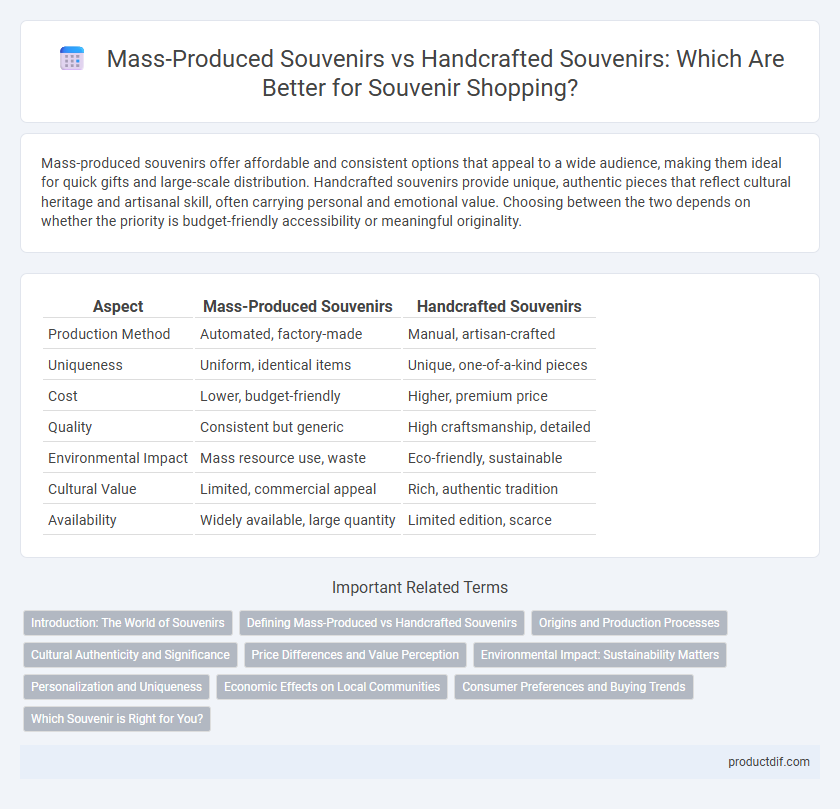Mass-produced souvenirs offer affordable and consistent options that appeal to a wide audience, making them ideal for quick gifts and large-scale distribution. Handcrafted souvenirs provide unique, authentic pieces that reflect cultural heritage and artisanal skill, often carrying personal and emotional value. Choosing between the two depends on whether the priority is budget-friendly accessibility or meaningful originality.
Table of Comparison
| Aspect | Mass-Produced Souvenirs | Handcrafted Souvenirs |
|---|---|---|
| Production Method | Automated, factory-made | Manual, artisan-crafted |
| Uniqueness | Uniform, identical items | Unique, one-of-a-kind pieces |
| Cost | Lower, budget-friendly | Higher, premium price |
| Quality | Consistent but generic | High craftsmanship, detailed |
| Environmental Impact | Mass resource use, waste | Eco-friendly, sustainable |
| Cultural Value | Limited, commercial appeal | Rich, authentic tradition |
| Availability | Widely available, large quantity | Limited edition, scarce |
Introduction: The World of Souvenirs
Mass-produced souvenirs dominate tourist markets with uniform designs and affordable prices, appealing to bulk buyers and casual tourists. Handcrafted souvenirs offer unique cultural significance and intricate artistry, reflecting local heritage and personalized craftsmanship. Choosing between these options depends on the desire for authenticity versus convenience and cost-efficiency.
Defining Mass-Produced vs Handcrafted Souvenirs
Mass-produced souvenirs are items manufactured in large quantities using automated processes, ensuring uniformity and lower costs, while handcrafted souvenirs are individually created by artisans, often reflecting unique cultural or artistic elements. Mass-produced souvenirs typically prioritize affordability and wide availability, whereas handcrafted souvenirs emphasize authenticity, craftsmanship, and cultural significance. Understanding these distinctions helps consumers appreciate the value and origin of the souvenirs they choose.
Origins and Production Processes
Mass-produced souvenirs are typically manufactured in large factories using automated processes and standardized materials, originating from global supply chains aimed at mass distribution and affordability. Handcrafted souvenirs originate from local artisans who utilize traditional techniques and locally sourced materials, reflecting cultural heritage and unique craftsmanship. The production processes of handcrafted items involve detailed manual work, imbuing each piece with individuality, whereas mass-produced souvenirs rely on efficiency and uniformity to meet high consumer demand.
Cultural Authenticity and Significance
Mass-produced souvenirs often prioritize affordability and availability over cultural authenticity, resulting in generic items that lack connection to local traditions. Handcrafted souvenirs embody the cultural significance of the region, showcasing unique artisan skills and traditional techniques passed down through generations. Choosing handcrafted souvenirs supports local communities and preserves cultural heritage by offering meaningful, authentic mementos.
Price Differences and Value Perception
Mass-produced souvenirs typically offer lower price points due to economies of scale and standardized production processes, making them accessible to a broader audience. Handcrafted souvenirs command higher prices reflecting the artisans' skill, time investment, and unique craftsmanship, which enhances perceived value and emotional connection. Consumers often associate handcrafted items with authenticity and cultural significance, justifying the premium compared to the uniformity of mass-produced products.
Environmental Impact: Sustainability Matters
Mass-produced souvenirs often rely on non-renewable materials and energy-intensive manufacturing processes, leading to significant environmental degradation and waste generation. Handcrafted souvenirs typically use locally sourced, sustainable materials and traditional techniques that reduce carbon footprints and support biodiversity. Choosing handcrafted souvenirs promotes eco-friendly practices and helps mitigate the environmental impact associated with mass production.
Personalization and Uniqueness
Mass-produced souvenirs often lack personalization, offering uniform designs that appeal to a broad audience but fail to capture individual memories or local character. Handcrafted souvenirs provide a unique and personalized experience, reflecting artisanal skill and cultural authenticity that mass-produced items cannot replicate. This distinctiveness enhances sentimental value, making handcrafted souvenirs more meaningful keepsakes for travelers.
Economic Effects on Local Communities
Mass-produced souvenirs generate significant revenue through large-scale distribution but often funnel profits away from local communities, limiting economic benefits. Handcrafted souvenirs support local artisans directly, fostering sustainable income and preserving cultural heritage while enhancing community resilience. Investing in handcrafted goods promotes economic diversification and empowers small businesses, contributing to long-term regional development.
Consumer Preferences and Buying Trends
Consumers increasingly favor handcrafted souvenirs for their uniqueness and authentic cultural value, driving demand for artisanal products over mass-produced items. While mass-produced souvenirs offer affordability and wide availability, the rising preference for sustainable and personalized gifts shifts buying trends towards limited-edition and locally crafted memorabilia. Market analysis shows a growing segment of buyers prioritizing quality, storytelling, and ethical production when selecting souvenirs.
Which Souvenir is Right for You?
Mass-produced souvenirs offer affordability and uniformity, making them ideal for budget-conscious travelers seeking easily recognizable keepsakes. Handcrafted souvenirs provide unique, culturally rich items that support local artisans and offer authentic memories for collectors valuing originality. Choosing between them depends on the importance of cost efficiency versus cultural authenticity in your travel mementos.
Mass-Produced Souvenirs vs Handcrafted Souvenirs Infographic

 productdif.com
productdif.com